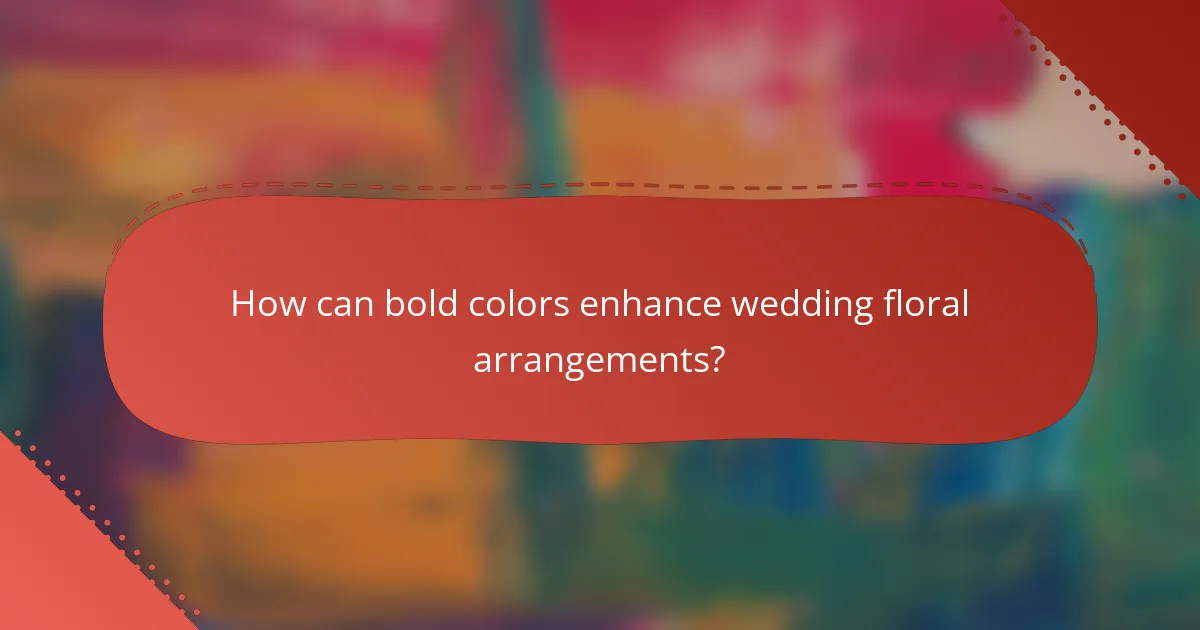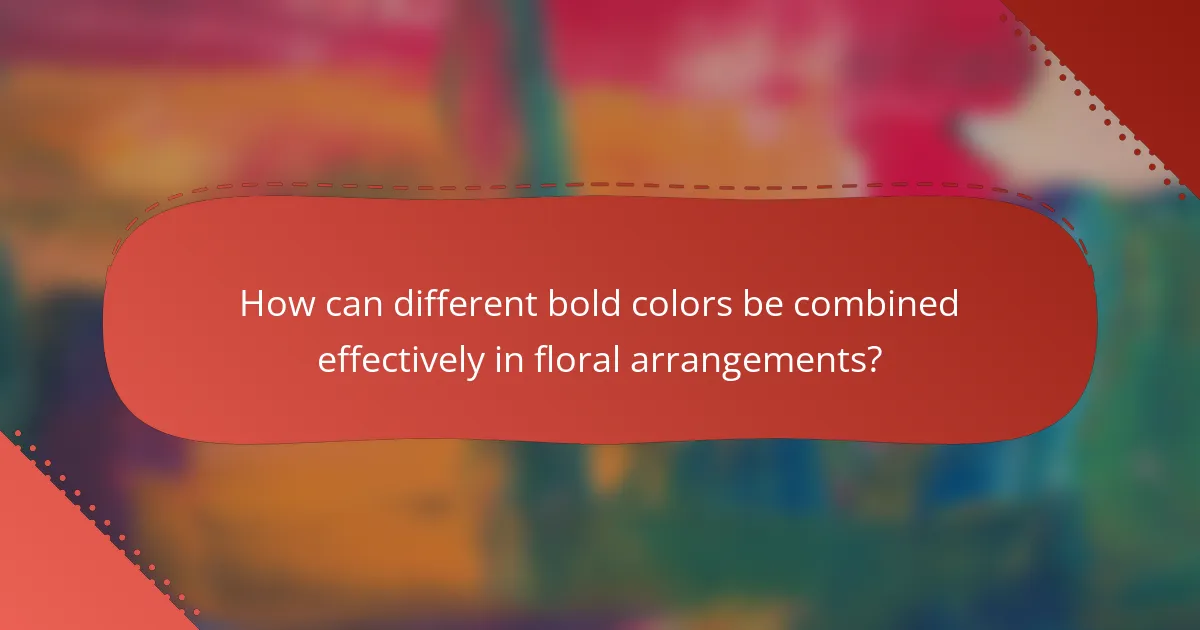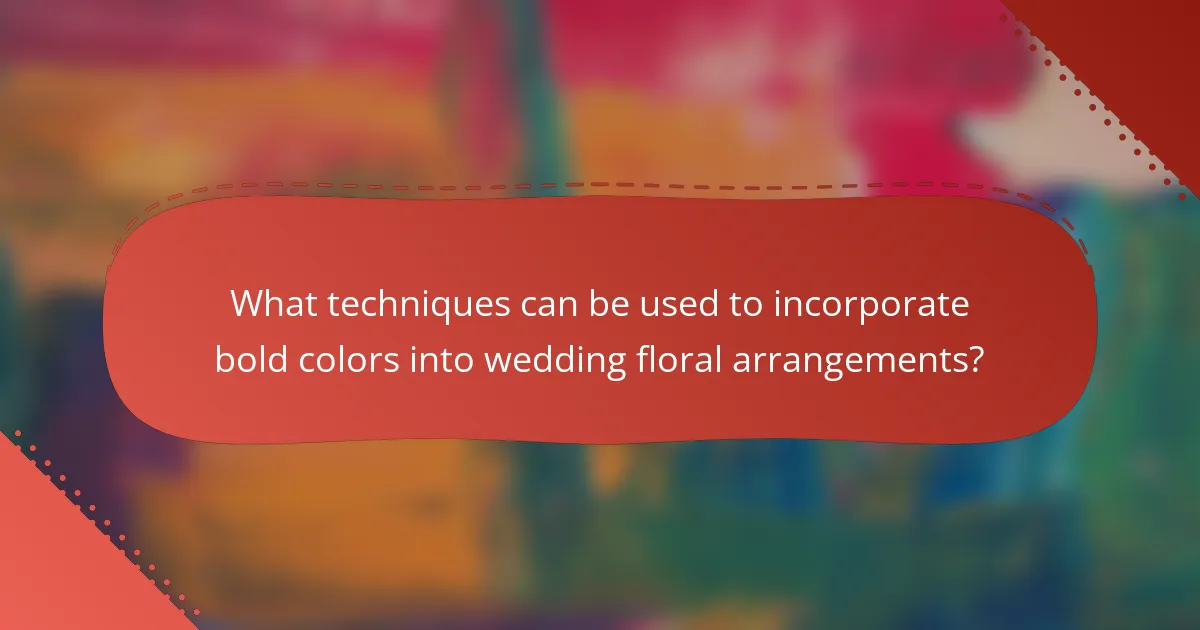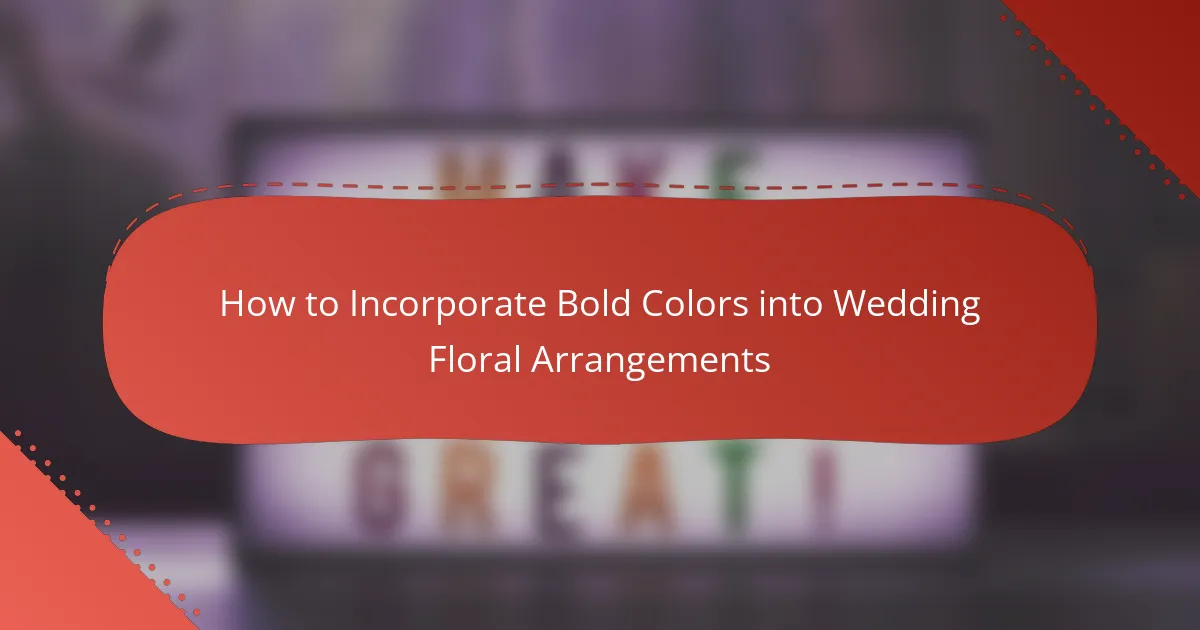
How can bold colors enhance wedding floral arrangements?
Bold colors can enhance wedding floral arrangements by creating visual impact and emotional resonance. They attract attention and evoke strong feelings. For example, vibrant reds can symbolize love, while bright yellows represent joy. These colors can also complement the wedding theme and decor. Using bold colors adds depth and dimension to arrangements. They can make bouquets and centerpieces stand out. Studies show that colors can influence mood and perception, making bold choices effective in enhancing the overall atmosphere.
What are the key benefits of using bold colors in wedding flowers?
Bold colors in wedding flowers create a vibrant and lively atmosphere. They enhance the visual appeal of the arrangements. Bold colors can evoke strong emotions, making weddings feel more festive. They also provide a striking contrast against traditional white or pastel decor. This contrast can help highlight specific areas or themes within the wedding venue. Additionally, bold colors are memorable and can make photographs more striking. Studies show that vibrant colors can improve mood and energy levels. Using bold colors can also reflect the couple’s personality and style, making the event more personal.
How do bold colors influence the overall wedding theme?
Bold colors significantly impact the overall wedding theme by creating a vibrant and energetic atmosphere. They serve as focal points that can enhance the visual appeal of the event. Bold hues can evoke specific emotions, such as joy and excitement, which align with the celebratory nature of weddings.
Using bold colors in floral arrangements can unify various elements of the decor. For instance, bright floral displays can complement or contrast with other decor aspects like table settings and linens. This harmony or contrast helps to establish a cohesive theme throughout the venue.
Research indicates that color psychology plays a vital role in event planning. According to a study in the Journal of Environmental Psychology, colors can influence mood and perception. Thus, incorporating bold colors can elevate the overall experience for guests.
What emotions do bold colors evoke in wedding settings?
Bold colors in wedding settings evoke feelings of joy, excitement, and passion. These vibrant hues can create an atmosphere of celebration. For example, red symbolizes love and desire, while yellow represents happiness and optimism. Blue can evoke calmness and serenity, offering a balance to the vibrancy. Studies show that colors can influence emotions significantly. According to color psychology, warm colors tend to energize and uplift. In contrast, cool colors can provide comfort and relaxation. The combination of bold colors can enhance the overall emotional experience of the wedding. This emotional impact is crucial for creating memorable moments during the event.
What factors should be considered when choosing bold colors for wedding flowers?
Consider the wedding theme when choosing bold colors for flowers. The colors should complement the overall aesthetic of the event. Take into account the season, as certain colors resonate better during specific times of the year. For example, vibrant hues are popular in spring and summer. Additionally, consider the venue’s color palette and decor style. The lighting conditions can also affect how colors appear, so evaluate the venue’s natural and artificial light. Lastly, consider the preferences of the couple, as personal taste plays a significant role in color selection.
How does the season affect color selection for wedding flowers?
Seasonal changes significantly influence color selection for wedding flowers. In spring, pastel colors like blush pink and lavender are popular, reflecting the fresh blooms of the season. Summer favors vibrant hues such as bold reds and yellows, echoing the bright sunshine. Autumn brings rich tones like deep oranges and burgundies, aligning with the changing leaves. Winter often features whites, greens, and metallics, creating a classic and elegant look. Flower availability also varies by season, impacting color choices. For instance, peonies are abundant in spring, while dahlias are more prevalent in late summer. This seasonal availability helps couples choose colors that complement their wedding date and floral options.
What role does the wedding venue play in color choice?
The wedding venue significantly influences color choice for floral arrangements. Venues often have distinct architectural styles and color palettes. These elements can dictate which colors will harmonize or clash with the setting. For example, a rustic barn may favor earthy tones, while a modern hotel could suit vibrant hues. The venue’s lighting also affects color perception. Natural light can enhance bright colors, while dim lighting may mute them. Additionally, the venue’s seasonal decor can impact color decisions. Couples often seek to create a cohesive look that complements the venue’s aesthetic. By aligning floral colors with the venue, couples achieve a unified and visually appealing wedding design.

How can different bold colors be combined effectively in floral arrangements?
Different bold colors can be combined effectively in floral arrangements by using complementary color schemes. Complementary colors, such as blue and orange, enhance each other’s vibrancy. Additionally, utilizing a color wheel can guide the selection of colors that create harmony. Pairing bold colors with neutral tones, like white or green, can balance the overall look. Varying flower types and textures also adds depth to the arrangement. For instance, combining bold peonies with textured greenery can create visual interest. Research shows that color theory principles, such as the use of analogous colors, can lead to aesthetically pleasing designs. These methods ensure that the floral arrangements are striking yet cohesive.
What are some popular bold color combinations for wedding flowers?
Popular bold color combinations for wedding flowers include vibrant hues like fuchsia and orange. This pairing creates a lively and energetic atmosphere. Another striking combination is deep purple and bright yellow. This mix adds a touch of elegance and cheerfulness. Red and royal blue also make a bold statement, providing a dramatic contrast. Additionally, hot pink and turquoise can create a fun and modern look. These combinations are frequently chosen for their eye-catching appeal and ability to enhance the wedding theme.
How can contrasting colors create visual interest in arrangements?
Contrasting colors create visual interest in arrangements by enhancing the overall aesthetic appeal. They draw the viewer’s attention to specific elements within the arrangement. This effect occurs because contrasting colors, such as blue and orange or red and green, highlight each other. The use of these colors can evoke emotional responses and create a dynamic visual experience. Research indicates that color contrast can influence perception and engagement. According to the Color Theory, complementary colors placed together can intensify the vibrancy of each hue. This principle is widely used in design and art to create striking visuals. Therefore, incorporating contrasting colors in floral arrangements can significantly elevate their beauty and impact.
What monochromatic schemes can be used with bold colors?
Monochromatic schemes using bold colors include variations of a single hue in different shades, tints, and tones. For example, a bold red can be paired with lighter pinks and darker burgundies. This approach creates depth while maintaining a cohesive look. Such schemes enhance the visual impact of floral arrangements. They also allow for a striking yet harmonious aesthetic. Using a monochromatic palette can make bold colors stand out without overwhelming the design. This method is effective in wedding floral arrangements, ensuring that the overall appearance remains elegant and unified.
How can color theory be applied to wedding floral arrangements?
Color theory can be applied to wedding floral arrangements by using color combinations that evoke specific emotions. Complementary colors, such as orange and blue, create vibrant contrasts that attract attention. Analogous colors, like red, orange, and yellow, provide a harmonious and cohesive look. Monochromatic schemes, using different shades of a single color, can create a sophisticated and elegant effect.
Understanding the color wheel helps florists choose effective combinations. For instance, warm colors can evoke feelings of warmth and happiness, while cool colors can promote calmness. Research indicates that color influences perception and mood, supporting the use of color theory in design. Applying these principles can enhance the overall aesthetic and emotional impact of wedding floral arrangements.
What are the basics of color theory relevant to floral design?
Color theory basics relevant to floral design include the color wheel, color harmony, and the psychological effects of colors. The color wheel illustrates primary, secondary, and tertiary colors. Primary colors are red, blue, and yellow. Secondary colors are green, orange, and purple, formed by mixing primary colors. Tertiary colors result from mixing primary and secondary colors.
Color harmony involves combinations that are visually appealing. Complementary colors are opposite each other on the color wheel, creating contrast. Analogous colors are next to each other, providing a cohesive look. Monochromatic schemes use variations of a single color for depth.
The psychological effects of colors influence emotions and perceptions. For example, red evokes passion, while blue conveys calmness. Understanding these basics helps floral designers create arrangements that resonate emotionally with their audience.
How can complementary colors enhance floral arrangements?
Complementary colors can enhance floral arrangements by creating visual contrast. This contrast makes the flowers appear more vibrant and striking. For example, pairing orange flowers with blue foliage creates a dynamic effect. Such combinations draw attention and highlight the beauty of each element. Studies show that contrasting colors can increase visual interest and emotional response. This technique is often used in design to evoke feelings of excitement and energy. Using complementary colors can also help balance the overall composition of the arrangement. This balance leads to a more harmonious and appealing display.

What techniques can be used to incorporate bold colors into wedding floral arrangements?
Utilizing contrasting colors is an effective technique to incorporate bold colors into wedding floral arrangements. This method enhances visual impact and creates a dynamic aesthetic. Pairing bold colors with softer hues can balance the arrangement. For instance, vibrant reds can be combined with pastel pinks. Layering flowers with different shapes and sizes adds depth to the arrangement. Incorporating textured foliage can also complement bold blooms. Using colored vases or containers enhances the overall presentation. Additionally, strategic placement of flowers can draw attention to the bold colors. These techniques ensure that bold colors are effectively showcased in wedding floral designs.
How can flower selection impact the use of bold colors?
Flower selection significantly influences the use of bold colors in floral arrangements. Choosing flowers with vibrant hues enhances the overall visual impact. For example, flowers like roses, dahlias, and sunflowers provide strong color saturation. These bold colors can create focal points in arrangements, drawing attention to specific areas. Additionally, contrasting colors can be achieved by pairing bold flowers with softer tones. This contrast amplifies the boldness of the selected colors. The seasonality of flowers also affects color availability, impacting choices for bold arrangements. Ultimately, the right flower selection can elevate the aesthetic appeal of wedding floral designs.
What types of flowers are best for showcasing bold colors?
Roses, tulips, and dahlias are the best flowers for showcasing bold colors. Roses come in vibrant shades like red, orange, and yellow. Tulips offer bright colors such as pink, purple, and white. Dahlias feature rich colors including deep red and bright orange. These flowers have strong visual impact. Their hues stand out in floral arrangements. They are often used in weddings for dramatic effect. Their vibrant colors enhance the overall aesthetic of the arrangements.
How can texture and shape complement bold colors in arrangements?
Texture and shape enhance bold colors in arrangements by adding depth and interest. Textures like smooth, rough, or velvety create contrast against vibrant hues. Shapes such as geometric or organic forms can draw attention to bold colors. For instance, a round flower can soften the impact of a bright color. Meanwhile, angular shapes can emphasize the intensity of bold tones. This interplay creates visual balance and harmony. Studies show that varied textures and shapes can increase viewer engagement in floral designs.
What design techniques can enhance bold color use in floral arrangements?
Utilizing contrast is a key design technique that enhances bold color use in floral arrangements. Pairing bold colors with neutral or softer shades creates visual balance. This technique allows the vibrant hues to stand out without overwhelming the viewer. Incorporating varied textures can also amplify the impact of bold colors. Textured elements, such as foliage or unique flower shapes, add depth and interest.
Another effective technique is the use of color blocking. This involves grouping bold colors together in distinct sections. This method creates a striking visual effect and draws attention to each hue. Additionally, varying the scale of flowers can enhance bold color use. Large blooms can dominate a space, while smaller flowers can provide contrast and support the overall design.
Strategic placement of flowers is crucial. Positioning bold colors at focal points captures attention effectively. Using asymmetrical arrangements can also enhance the dynamic quality of bold colors. This style creates movement and guides the eye through the arrangement. Overall, these design techniques work together to elevate the use of bold colors in floral arrangements.
How can layering and grouping of flowers create depth?
Layering and grouping of flowers can create depth by providing visual contrast and dimension. This technique allows different heights and shapes of flowers to interact. When taller flowers are placed behind shorter ones, it enhances the overall arrangement. Grouping flowers of similar colors can also create a focal point. This draws the eye and adds interest. Additionally, varying the types of flowers introduces texture. Textural differences can make arrangements more dynamic. Using this method, florists can achieve a more three-dimensional look. Depth in floral arrangements can elevate the aesthetic appeal significantly.
What are the benefits of using greenery with bold colors?
Using greenery with bold colors enhances visual appeal and creates striking contrasts. This combination adds depth to floral arrangements. Greenery provides a natural backdrop that highlights vibrant hues. Bold colors draw attention and evoke emotions, making arrangements more memorable. The contrast between greenery and bold colors can symbolize growth and celebration. Studies show that vibrant colors can positively affect mood and atmosphere. This approach is effective in wedding settings, where ambiance is crucial. Overall, using greenery with bold colors elevates the aesthetic quality of floral designs.
What practical tips can help in successfully incorporating bold colors into wedding floral arrangements?
Use contrasting colors to create visual interest in wedding floral arrangements. Pair bold colors with neutral shades to balance the vibrancy. Incorporate various flower types to add texture and depth. Use greenery to soften the bold hues and provide a natural backdrop. Consider the venue’s color scheme to ensure harmony with the overall aesthetic. Utilize different flower sizes to create dynamic arrangements. Experiment with shapes and heights for added dimension. Lastly, keep seasonal availability in mind for the best quality and freshness.
The main entity of the article is bold colors in wedding floral arrangements. The article explores how bold colors enhance visual impact, evoke emotions, and complement wedding themes. It outlines the benefits of using vibrant hues, factors influencing color selection, and the role of the wedding venue. Additionally, it discusses techniques for effectively combining bold colors, popular color combinations, and the importance of flower selection, texture, and shape in creating visually appealing arrangements. Practical tips for incorporating bold colors into wedding floral designs are also provided, ensuring a cohesive and memorable aesthetic.
